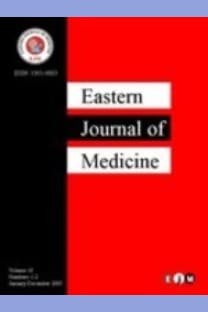Light microscopic determination of tissue
___
1. Grizzle WE. Special symposium: fixation and tissue processing models. Biotech Histochem 2009; 84: 185-193.2. Junqueira LC, Carneiro J. Basic Histology text & atlas, Nobel Medicine Bookstores, 2006; 1-2 (in Turkey).
3. Jamur MC, Oliver C. Cell fixatives for immunostaining. Methods Mol Biol 2010; 588: 55-61.
4. Pekmez H, Camcı NC, Zararsız İ, et al. The effect of melatonin hormone on formaldehyde induced liver injury: A light microscopic and biochemical study. Fırat Medical Journal 2008; 13: 92-97.
5. Yamashita S. Heat-induced antigen retrieval: Mechanisms and application to histochemistry. Progress in Histochemistry and Cytochemistry 2007; 41: 141-200.
6. van Essen HF, Verdaasdonk MA, Elshof SM, de Weger RA, van Diest PJ. Alcohol based tissue fixation as an alternative for formaldehyde: influence on immunohistochemistry. J Clin Pathol 2010; 63: 1090-1094.
7. Zararsız M, Kuş H, Yılmaz HR, Köse E, Sarsılmaz M. Antioxidant Effects Of Omega-3 Fatty Acids on Experimental Formaldehyde Toxicity induced İnjury of Hippocampus. FU Journal of Health Sciences 2008; 22: 59-64.
8. Ünsaldı E, Çiftci MK. Formaldehyde and its using areas, risk group, harmful effects and protective precautions against it. YYU Journal of Veterinary Medicine 2010; 21: 71-75.
9. Gugic D, Nassiri M, Nadji M, Morales A, Vincek V. Novel tissue preservative and tissue fixative for comparative pathology and animal research. Journal of Experimental Animal Science 2007; 43: 271-281.
10. Werner M, Chott A, Fabiano A, Battifora H. Effect of formalin tissue fixation and processing on immunohistochemistry. The American Journal of Surgical Pathology 2000; 24: 1016-1019.
11. Tingstedt JE, Tornehave D, Lind P, Nielsen J. Immunohistochemical detection of SWC3, CD2, CD3, CD4 and CD8 antigens in paraformaldehyde fixed and paraffin embedded porcine lymphoid tissue. Veterinary Immunology and Immunopathology 2003; 15: 94: 123-132.
12. Aktan TM, Cüce G, Tosun Z, Duman S. The effects of different fixatives on immunohistochemical staining of skin tissue. European Journal of Basic Medical Sciences 2012; 2: 46-49.
13. Bancroft JD, Stevens A, Turner DR. Theory and practice of histological techniques. Churchill Livingstone 1996; 1: 29-32 (in New York).
14. Hopwood D. The reactions of glutaraldehyde with nucleic acids. Histochemistry of Journal 1975; 7: 267-276.
15. Medawar PB. A second study of the behaviour and fate of skin homografts in rabbits: A Report to the War Wounds Committee of the Medical Research Council. J Anat 1945; 79: 157-176.
16. http://www.leicabiosystems.com/pathologyleade rs/fixation-and-fixatives-4-popular-fixativesolutions.
- ISSN: 1301-0883
- Yayın Aralığı: 4
- Başlangıç: 1996
- Yayıncı: ERBİL KARAMAN
GÖKNUR ÖZAYDIN YAVUZ, NECMETTİN AKDENİZ, İBRAHİM HALİL YAVUZ, Ömer ÇALKA, SERAP GÜNEŞ BİLGİLİ
Ultrasound-guided bilateral infraclavicular block in a pediatric patient: Case report
Light microscopic determination of tissue
Fadime KAHYAOĞLU, Alpaslan GÖKÇİMEN
Hospitalization timeliness of patients with myocardial infarction
Tengiz VERULAVA, Tamar MAGLAKELİDZE, Revaz JORBENADZE
NEŞE ÇÖLÇİMEN, MURAT ÇETİN RAĞBETLİ, Mikail KARA, OKAN ARIHAN, Veysel AKYOL
CİHAN ADANAŞ, Yunus Erdem UYMUR, SEZAİ ÖZKAN, Şehmuz KAYA
Multislice computed tomography imaging of gastrointestinal stromal tumors
Nadir SEZER, Muhammed Akif DENİZ, Zelal DENİZ TAŞ, CEMİL GÖYA, EŞREF ARAÇ, Mehmet EMİN
Irritable bowel syndrome, depression and anxiety
Cafer ALHAN, ASLIHAN OKAN İBİLOĞLU
Masayuki HİGASHİNO, Masashi OHE, Ken FURUYA, Yoichi SANEFUJİ, Norie ITO, Naoya HATTORİ
